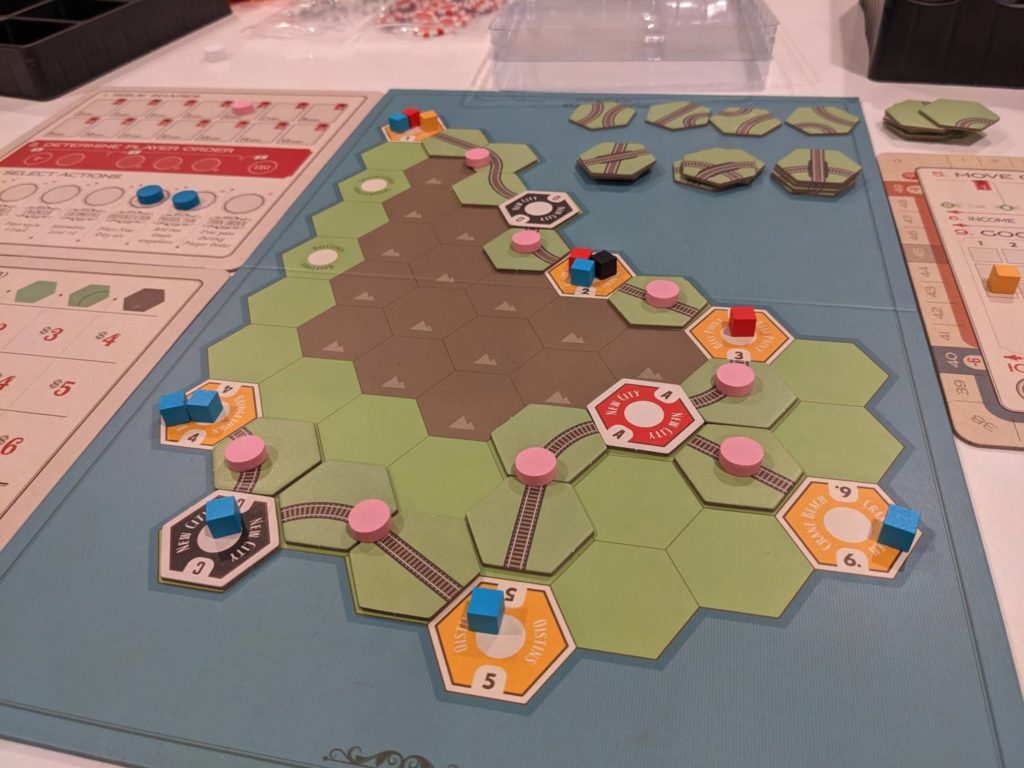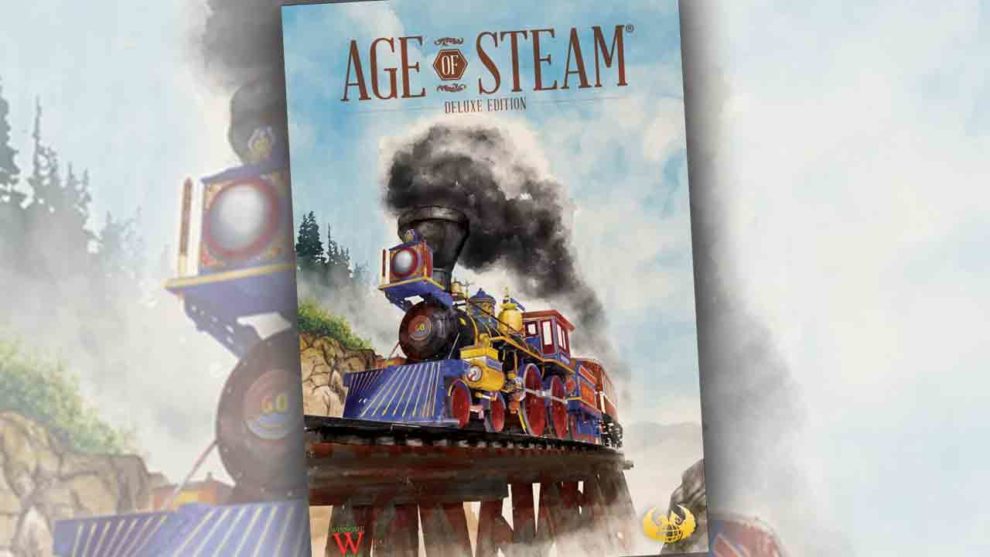Disclosure: Meeple Mountain received a free copy of this product in exchange for an honest, unbiased review. This review is not intended to be an endorsement.
Right now, I’m digging into train games pretty hard.
Cube rail games, like Iberian Games. Short train games like Village Rails. Medium-weight games, like Chicago Express. Long train games, such as 1846: The Race for the Midwest. Online train games, on 18xx.games. Fantasy train games, like Empyreal: Spells & Steam.
If there’s a reason to play a train-adjacent game in 2023, generally speaking, I’m playing it. I think that’s because I spent most of my gaming career avoiding games like this, so I want to be inclusive as I consider this category. Are train games for me? I’m going to do everything I can to find out for sure, especially if I can break out my poker chips to substitute out crappy paper money.
I have spent a good part of the last two years with Meeple Mountain attempting to build a relationship with Eagle-Gryphon Games. I’m excited to share that this mission was a success. Over the next two or three months, I’m going to be posting a number of Eagle-Gryphon articles.
Most of my friends think of Eagle-Gryphon as the Vital Lacerda shop. Lacerda has designed many of the most beloved strategy games ever made, such as The Gallerist, Vinhos: Deluxe Edition and Kanban EV.
In fact, Eagle-Gryphon has a massive catalog of other games and our team will do our best to introduce some of that catalog soon.
Combining my current love of train games and my interest in trying more Eagle-Gryphon products, it was only natural to start with Age of Steam, first published all the way back in 2002 when Eagle-Gryphon was simply Eagle Games. It’s twenty years old, and seems to get an updated map pack every few years that ups player choices.
I played Age of Steam a few years ago but worked through the base game again recently to see how play has held up. In many ways, it is still a classic. In other ways, it is still a train game, which means different things to different people.
No matter what, Age of Steam leans hard into the word “cutthroat.” Bring a shiv!

Rails, Cubes, But Maybe Not Cube Rails
Age of Steam has been categorized a hundred different ways, but my view hasn’t changed since the first time I played.
Age of Steam is mostly a strategy game featuring route building, goods delivery, and special player advantages that change from turn to turn. It’s famously tight with money over its first few rounds. It is not a market manipulation game. It does feature player elimination, which apparently is OK in Age of Steam but is not OK in almost every other gaming context.
It also features a small but noticeable amount of luck.
The best thing about the deluxe version of Age of Steam: variety. Right out of the box, you’ve got six different maps to play on, scaled to the player count. One map is included for solo play, one map for two players, and four maps that accommodate 3-6 players. The variety within the four large-player-count maps is fantastic, and some break the base game’s rules around pricing and track restrictions in fun ways.
Each player serves as an investor in only one company: their own. (This is a change from lots of the 18XX and “cube rails” games I own.) These investors have to carefully manage their money by building track towards destinations that desire goods matching the color of the city they are being delivered to. That means that a red city only pays for red cubes, and so on. The way you will make the most money is a little counterintuitive: by sending a good from the farthest possible location (ideally six connections away, which usually only happens late in the game) to a destination, which provides the largest boost in income.
Victory points are computed at the end of play: three points per step forward on the income track, and one point for each section of track that comprised part of a point-to-point connection, known as a “Completed Railroad Link.” Subtract from that three points for each share you issued, and you spit out a final score. Ties are shared.
Each of the game’s rounds—scaled to player count—runs the same way. Get money by issuing shares, then bid for turn order. Select a special power for that round only, then build track and move goods. Cleanup involves computing your income from goods sold, expenses from your issued shares and the reach of your (unrepresented) locomotive, and reducing your income before putting more goods onto the map.
It’s this last part that I want to address first.

Goods Growth (Growth Not Guaranteed)
Step 9 is known as “Goods Growth.” During this phase, cubes in the game’s five colors are taken from a goods display on the board. These cubes are then placed in their matching city on the map, repopulating those cities with goods that can be moved by players who have track connected to that location.
How are those cubes chosen? Dice. (Wait, hardcore strategy gamer, come back! Dice are only used for this one phase of the game!!) Dice are rolled based on the player count, and goods are taken from the display to be placed on the board. That may sound like one good per player, but the reality is different: the goods might end up in places that only one or two players actually have track.
The fun part about this (and I’m going to use the term “fun” loosely here, since I’ve been both the beneficiary and the victim of this “fun” during my review plays of Age of Steam) is watching people curse dice rolls that didn’t provide a player with any new goods to move in the next round. This really gets dicey—whoops!—in a high player count game. I have only played Age of Steam once at five players, but man, every turn was a fight to move the limited goods from one of my cities.
Optionally, before the Goods Growth phase, a player might have chosen the “Production” action during the player power choice phase known as Select Actions. If so, that player can randomly—RANDOMLY—draw two goods from a draw bag to place anywhere in the goods display before the dice are rolled.
Yes, BEFORE the dice are rolled.
I’m ready to say that Production is the worst thing about Age of Steam. While this is relative—Age of Steam is beloved by many, despite this “power”—Production feels like it is generally worthless. I would be happier if I could just announce to the table “I’m putting $500 on the 17” at a roulette table, then just hoping that the cute little white “pill” lands on my number.
The rulebook literally reminds players that Production is a non-starter in phase one, so in a six-player game, you can only use Production four times, because you also can’t use Production in the last round. It already feels like Production doesn’t work…but then, when you do use it, the result is also pretty worthless.
Luckily, the rest of the experience is really strong.

Come for the Gameplay, Stay for the Variety
Age of Steam, 21 years after its initial release, keeps chugging right along. I’m only playing with the six maps in the deluxe edition, but there are so many more ways to play now. The production quality, in typical Eagle-Gryphon fashion, is glorious; for about $100, you can get yourself a pretty handsome package with beautiful boards, a fantastic insert, and mini poker chips that replace the original game’s paper money. (Not that you ever have enough money, but still.)
I have a few friends that swear this is the greatest train game ever made. Me? I like it, but prefer other games over it (particularly now that I’m playing more 18XX games). That said, Age of Steam is such an easy game to teach that I will keep my review copy mainly because I’ll happily play it as a shorter alternative to 18XX games. While I’ve only played Age of Steam five times now (solo twice, and once at three, four, and five players), this is one that fits nicely as an option when I want to get nearly any player count to the table and everyone knows how to play.
A note about the game length: I prefer Age of Steam at higher player counts (four or more). At three players, the game runs a full ten rounds; that’s too long for a game where one player often has things under control and other players may struggle to catch up. At five players, this is a seven-round game; gameplay will be tight and experienced players should be able to knock that out in about two hours.
I did try the solo map, Barbados, which was built by guest designer Ted Alspach (the leader of Bezier Games, and the designer of the excellent train game Maglev Metro). It’s pretty good, but I’m not sure I can recommend buying Age of Steam only for the solo mode. Barbados is an interesting challenge and a fun teaching tool for players looking to try the game before unleashing the full game on their normal game group.
Age of Steam is still ranked in the top 200 on BGG, a testament to its staying power. I highly recommend giving this a look if you haven’t already!












Add Comment